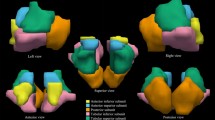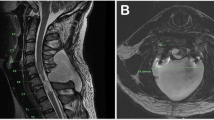Abstract
Background:
Postprandial hypotension (PPH) appears in various conditions with autonomic failure and was symptomatic in a patient with thoracic paraplegia, but was not remarkable in patients with tetraplegia.
Objective:
To determine whether the pathology causing PPH may include a thoracic but not a cervical spinal cord lesion (SCL).
Design:
An experimental controlled study.
Setting:
The spinal research laboratory, Loewenstein Hospital, Raanana, Israel.
Subjects:
Thirteen healthy subjects, 10 patients with traumatic T4–T6 paraplegia, and 11 patients with traumatic C4–C7 tetraplegia.
Main outcome measures:
Heart rate (HR), blood pressure (BP), HR and BP spectral components (LF, HF, LF/HF), cerebral blood flow velocity (CBFV), and cerebrovascular resistance index (CVRi).
Methods:
The effects of a standard liquid meal on the outcome measures were compared between the three subject groups monitored for HR, BP, and CBFV, from 55 min before to 45 min after the start of the meal. The recorded signals were digitized online and analyzed off-line in the time and frequency domains.
Results:
After meal, BP decreased only in the paraplegia group (P<0.01), HR increased more prominently in this group (P<0.01), CVRi tended to decrease only in the paraplegia group, CBFV did not change significantly in any group, and HR LF/HF increased (P<0.001) in all groups but tended to increase more in paraplegia.
Conclusions:
Patients with mid-thoracic SCL may develop PPH. The pathology causing PPH can include a thoracic but not a cervical SCL. The normal hemodynamic reaction to liquid meal ingestion is mediated through the mid-thoracic spinal cord. The sympathovagal balance increases after food ingestion, more prominently in patients with PPH, and cerebrovascular resistance changes during PPH may help maintain the cerebral circulation.
Similar content being viewed by others
Log in or create a free account to read this content
Gain free access to this article, as well as selected content from this journal and more on nature.com
or
References
Mathias CJ, Bannister R . Postprandial hypotension in autonomic disorders. In: Mathias CJ, Bannister R (eds). Autonomic Failure. Oxford University Press: Oxford 1999, pp 283–295.
Masuda Y, Kawamura A . Role of the autonomic nervous system in postprandial hypotension in elderly persons. J Cardiovasc Pharmacol 2003; 42 (Suppl 1): 23–26.
Niimi Y et al. Clinical and physiological characteristics of autonomic failure with Parkinson's disease. Clin Autonom Res 1999; 9: 139–144.
Baliga RR, Catz A, Watson LD, Short DJ, Frankel HL, Mathias CJ . Cardiovascular and hormonal responses to food ingestion in humans with spinal cord transection. Clin Autonom Res 1997; 7: 137–141.
Catz A, Mendelson L, Solzi P . Symptomatic postprandial hypotension in high paraplegia. Case report. Paraplegia 1992; 30: 582–586.
Maynard FM et al. International standards for neurological and functional classification of spinal cord injury. Spinal Cord 1997; 35: 266–274.
Keselbrener L, Akselrod S . Selective discrete Fourier transform algorithm for time-frequency analysis: method and application on simulated and cardiovascular signals. IEEE Trans Biomed Eng 1996; 43: 789–802.
DeWitt LD, Wechsler LR . Transcranial Doppler. Stroke 1988; 19: 915–922.
Mathias CJ, Frankel HL . Autonomic disturbances in spinal cord lesions. In: Mathias CJ, Bannister R (eds). Autonomic Failure. Oxford University Press: Oxford 1999, pp 494–513.
Akselrod S . Spectral analysis of fluctuations in heart rate and other cardiovascular parameters as a tool for assessment of autonomic control. In: Korczyn AD (ed). Handbook of Autonomic Nervous System Dysfunction. Marcel Decker: New York 1995, pp 469–493.
Lu CL, Zou X, Orr WC, Chen JD . Postprandial changes of sympathovagal balance measured by heart rate variability. Dig Dis Sci 1999; 44: 857–861.
Kawaguchi R, Nomura M, Miyajima H, Nakaya Y, Mouri S, Ito S . Postprandial hypotension in elderly subjects: spectral analysis of heart rate variability and electrogastrograms. J Gastroenterol 2002; 37: 87–93.
Poli L, Bo M, Secreto P, Zanocchi M, Bottino P . Age-related transcranial Doppler findings in the evaluation of cerebral circulation during postprandial and postural tests. Cerebrovasc Dis 1999; 9: 98–101.
Krajewski A, Freeman R, Ruthazer R, Kelley M, Lipsitz LA . Transcranial Doppler assessment of the cerebral circulation during postprandial hypotension in the elderly. J Am Geriatr Soc 1993; 41: 19–24.
Goodman Gilman A, Goodman L, Gilman A . The Pharmacol Basis of Therapeutics. Macmillan Publishing: New York 1980, pp 652.
Sica DA, Midha M, Aronoff G, Bergen G . Atrial natriuretic factor in spinal cord injury. Arch Phys Med Rehabil 1993; 74: 969–972.
Hoost U et al. Haemodynamic effects of eating: the role of meal composition. Clin Sci (London) 1996; 90: 269–276.
Schroeder C et al. Water drinking acutely improves orthostatic tolerance in healthy subjects. Circulation 2002; 106: 2806–2811.
Shannon JR et al. Water drinking as a treatment for orthostatic syndromes. Am J Med 2002; 112: 355–360.
Jones KL et al. Effects of drink volume and glucose load on gastric emptying and postprandial blood pressure in healthy older subjects. Am J Physiol Gastrointest Liver Physiol 2005; 289: G240–G248.
van Orshoven NP, Oey PL, van Schelven LJ, Roelofs JM, Jansen PA, Akkermans LM . Effect of gastric distension on cardiovascular parameters: gastrovascular reflex is attenuated in the elderly. J Physiol 2004; 555 (Part 2): 573–583.
Acknowledgements
This study was supported by the Unit of Medical Services, Rehabilitation Department, Israel Ministry of Defense, and by the Tel-Aviv University Research Fund. The Transcranial Doppler device was provided for the study by Rimed Ltd, Israel. We thank Mrs Ora Philo and the nursing team of the Spinal Rehabilitation Department in Loewenstein Hospital for their help.
Author information
Authors and Affiliations
Rights and permissions
About this article
Cite this article
Catz, A., Bluvshtein, V., Pinhas, I. et al. Hemodynamic effects of liquid food ingestion in mid-thoracic paraplegia: is supine postprandial hypotension related to thoracic spinal cord damage?. Spinal Cord 45, 96–103 (2007). https://doi.org/10.1038/sj.sc.3101939
Published:
Issue date:
DOI: https://doi.org/10.1038/sj.sc.3101939
Keywords
This article is cited by
-
Treatment of postprandial hypotension with acarbose in an adult with cervical spinal cord injury: a case report
Spinal Cord Series and Cases (2023)
-
A case of postprandial hypotension in an individual with cervical spinal cord injury: treatment with acarbose
Spinal Cord Series and Cases (2019)
-
Influence of the neurological level of spinal cord injury on cardiovascular outcomes in humans: a meta-analysis
Spinal Cord (2012)
-
Hemodynamic responses to head-up tilt after spinal cord injury support a role for the mid-thoracic spinal cord in cardiovascular regulation
Spinal Cord (2011)
-
Insulin resistance in tetraplegia but not in mid-thoracic paraplegia: is the mid-thoracic spinal cord involved in glucose regulation?
Spinal Cord (2011)



